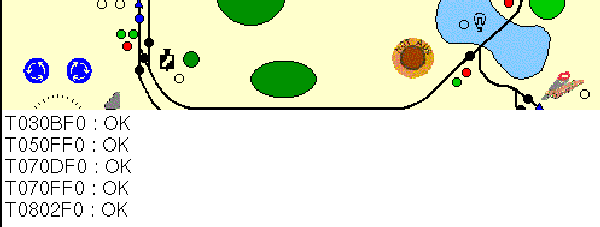LGB - a control - Software SingleChip PC
The SingleChip-PC's Software
is nothing but a single program, which handles the communications between the SingleChip-PC's webserver, other computers talking HTML (f.i. the handheld) and the layout's components.
The program starts automatically on the SingleChip-PC's power up and as a part of the black-box strategy it remains invisible to the user.

This software's main task
is interpreting HTML instructions originating from some source on the network. After an instruction has passed a check for logical correctness, it is converted into a format which is readable by the modules and it is then passed to the module via the RS485 bus. The modules' reply regarding a successfully executed or failed instruction is examined by this program too and is passed to the browser in form of a HTML page which is being displayed in a seperate frame, then.

Feedback frame superimposed in browser's display
Depending upon the settings, this feedback frame can remain invisible, which will be most comfortable for normal operations.
Futhermore, the software is used to query particular modules for their configuration parameters. This information is then used to synchronize segments of the tracks or to take certain conditions into regard when triggering particular functions.

Manually inquiring the parameters' settings
is interpreting HTML instructions originating from some source on the network. After an instruction has passed a check for logical correctness, it is converted into a format which is readable by the modules and it is then passed to the module via the RS485 bus. The modules' reply regarding a successfully executed or failed instruction is examined by this program too and is passed to the browser in form of a HTML page which is being displayed in a seperate frame, then.

Feedback frame superimposed in browser's display
Depending upon the settings, this feedback frame can remain invisible, which will be most comfortable for normal operations.
Futhermore, the software is used to query particular modules for their configuration parameters. This information is then used to synchronize segments of the tracks or to take certain conditions into regard when triggering particular functions.

Manually inquiring the parameters' settings

